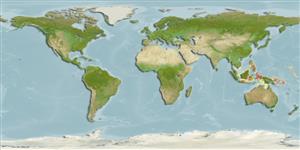Common names from other countries
>
Gobiiformes (Gobies) >
Gobiidae (Gobies) > Gobiinae
Etymology: Trimma: Greek, trimma, -atos = something crushed (Ref. 45335); habrum: Name from the Greek word ‘habros’, meaning delicate, dainty or graceful, referring to the soft and delicate shades of colour of freshly collected specimens..
More on author: Winterbottom.
Environment: milieu / climate zone / depth range / distribution range
Écologie
marin démersal; profondeur 60 - 70 m (Ref. 90102). Tropical
Western Pacific Ocean: Indonesia.
Taille / Poids / Âge
Maturity: Lm ? range ? - ? cm
Max length : 1.8 cm SL mâle / non sexé; (Ref. 87358)
Description synthétique
Morphologie | Morphométrie
Épines dorsales (Total): 7; Rayons mous dorsaux (Total): 8-9; Épines anales 1; Rayons mous anaux: 8 - 9. This species is distinguished by the following characters: a bony interorbital width equal to the pupil diameter, predorsal midline with 8-9 scales; unbranched pectoral fin rays 14; an unbranched fifth pelvic fin ray; no basal membrane joining the fifth pelvic fin rays across the midline; usually a single full row of cheek scales; scales on the upper two-thirds of the opercle; when fresh, colouration is diagnostic - a pale translucent dorsum with light yellow blotches and the base of each element of the dorsal fin surrounded by a red spot, a thin red bar along the posterior margins of the hypurals, no dark pigment at all on the hypural region of the peduncle, and a darkly pigmented covering to the dorsal margins of the swim bladder, neural sheath, and the brain (Ref. 87358).
Inhabits vertical walls and deep reef in about 60-70 m (Ref. 90102).
Life cycle and mating behavior
Maturité | Reproduction | Frai | Œufs | Fécondité | Larves
Winterbottom, R., 2011. Six new species of the genus Trimma (Percomorpha; Gobiidae) from the Raja Ampat Islands, Indonesia, with notes on cephalic sensory papillae nomenclature. aqua, Int. J. Ichthyol. 17(3):127-162. (Ref. 87358)
Statut dans la liste rouge de l'IUCN (Ref. 130435)
CITES (Ref. 128078)
Not Evaluated
Menace pour l'homme
Harmless
Utilisations par l'homme
Plus d'informations
PaysZones FAOÉcosystèmesOccurrencesIntroductionsStocksÉcologieRégime alimentaireÉléments du régime alimentaireConsommation alimentaireRation
Noms communsSynonymesMétabolismePrédateursÉcotoxicologieReproductionMaturitéFraiFéconditéŒufsDéveloppement de l'œuf
Taille/ÂgeCroissanceLongueur-poidsLongueur-longueurFréquences de longueursMorphométrieMorphologieLarvesDynamique des populations larvairesRecrutementAbondance
RéférencesAquacultureProfil d'aquacultureSouchesGénétiqueElectrophoresesHéritabilitéPathologiesTraitementMass conversion
CollaborateursImagesStamps, Coins Misc.SonsCiguateraVitesseType de nageSurface branchialeOtolithesCerveauxVision
Outils
Articles particuliers
Télécharger en XML
Sources Internet
Estimates based on models
Preferred temperature (Ref.
115969): 27.2 - 28.2, mean 27.8 (based on 7 cells).
Phylogenetic diversity index (Ref.
82804): PD
50 = 0.5000 [Uniqueness, from 0.5 = low to 2.0 = high].
Bayesian length-weight: a=0.01023 (0.00477 - 0.02194), b=3.02 (2.84 - 3.20), in cm Total Length, based on LWR estimates for this (Sub)family-body shape (Ref.
93245).
Fishing Vulnerability (Ref.
59153): Low vulnerability (10 of 100).
